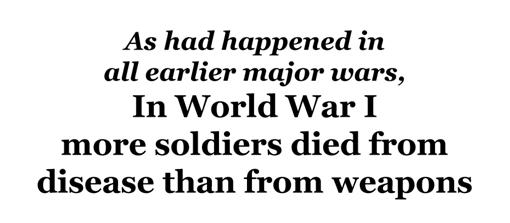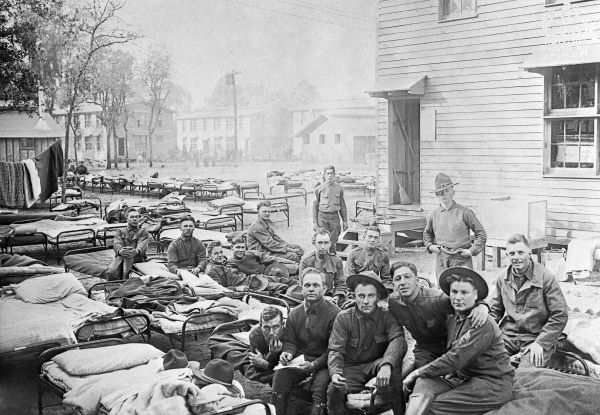In Harm's Way: Disease
Worse of Two Evils
Medical practice was primitive in 1918. Many doctors had "learned their medicine" from teachers who misunderstood or rejected Louis Pasteur's germ theory. No one yet grasped how viral and bacterial infections differed. Practicing doctors could only guess at how diseases spread. Doctors disagreed about how to treat even common illnesses. It should be no surprise that...

Let's look at how disease got to run rampant at Camp MacArthur, using measles as an example.
Measles had always existed, but it had not always reached epidemic levels. When children contracted it, they were kept home from school - a simple step that isolated the healthy from the sick, reducing the number of people infected. But things were different in wartime. Unless soldiers exhibited symptoms, they were moved around the country even after being exposed to it. They lived in high-density accommodations, and they traveled on overcrowded trains and ships.
At some point in 1917, unknown infected soldiers introduced measles to Camp MacArthur. The men stationed there had come from all over the country. They had been exposed in their youth to different diseases, and thus had varying immunities and susceptibilities. Perhaps thousands of them could catch measles - and they certainly would be given the chance: they lived cheek-by-jowl and constantly worked in close groups. Putting an infectious soldier into such a camp was like sending a free neutron into a critical mass of Uranium: the chain reaction would spread the disease at an alarming rate. Almost overnight, the camp became a measles incubator. Even casual contact with civilians (e.g., a group of soldiers might go into Waco for an evening, ride a trolley, sit in a movie theater, and along the way expose scores of people to measles) unleashed the virus en masse, simultaneously exposing far more civilians than ever would be exposed in peacetime, and propagating measles throughout the nearby civilian populace.
The scenario described above happened again and again, camp after camp, ship after ship, disease after disease. Through it all, healthy military personnel had to live and perform their duties in close proximity with their infected peers, unwittingly magnifying the spread of contagious disease. In its haste to prepare for war, the country was failing to safeguard the health of the public, and of the soldiers who would fight on its behalf.
*
A Different Flu
For years, heart disease and stroke had been the leading causes of death in America. That changed in 1918.
During the few days when Charles Wagner probably was too sick to sail to Europe, a handful of soldiers at a camp in Kansas were diagnosed with a new influenza. No one worried; every new wave of influenza was always a little different. The Army went about its business, its four million men clustered in camps like bees in hives. Like chicken pox, mumps, and measles before it, the new influenza began to fester in those camps.
Then it mutated, and became so deadly that some doctors who saw its victims mistook it for the Plague. It killed often, and it killed quickly - soldiers, nurses, even doctors collapsed without warning, and died within hours. To everyone's surprise, more than half of those it killed had been young, healthy adults. The disease triggered catastrophic immune responses, and young adults had the most robust immune systems - their bodies were well-suited for destroying themselves. Extreme allergic reactions rendered lung tissue useless for absorbing oxygen, or so damaged spinal nerves that victims died of meningitis.
Medical researchers advised the Federal government to cease cramming contagious men into trains, ships, and barracks - it refused. Even late in 1918, with the war's end in sight, overcrowded trains still carried soldiers to the eastern seaboard. By the time they reached their destinations, the corpses of flu victims were stacked in the baggage cars. Soldiers boarded overcrowded troop ships, and the deaths continued. Victims were buried at sea, at first only one or two each day, then more and more.
Some ranking Army doctors who heard about the warning misunderstood it. Over-impressed with the value of fresh air, they took what they considered a daring step: they moved the crowding outdoors. Thus, these men at Camp Joseph E. Johnston (where Sgt. Barry and Cpl. Wheeler had been posted) got to enjoy the steamy Gulf air - unaware that they should have been avoiding close contact.

floridamemory.com/items/show/141993
Forensic historians now believe that the cases of flu seen at that Kansas Army post were the first instances of this influenza recorded anywhere in the world. Although parallel paths of contagion may have existed, the progress of the disease across the U.S. can be tracked accurately by following it through the military. It went from one Army post to another, and from Navy ship to another, spreading to civilians in nearby communities and ports. Navy ships' visits to other nations coincided with the first influenza outbreaks in the South Pacific and Asia. American troop ships seem to have brought this influenza to England and France, whence it spread across Europe (even to Germany, via French prisoners-of-war).
*
The "Spanish" Influenza
Washington forbade American newspapers from reporting on the epidemic, so as not to panic the public (who, of course, already knew that all the funeral parlors for miles around had literally run out of caskets). Other combatant countries did the same. But in neutral Spain the press remained free, and it wrote about the country's horrible experiences with the deadly flu. As reports from Madrid got translated and distributed in other countries, the disease that had appeared in reality first in Kansas, but in print first in Spain, came to be known as "The Spanish Influenza."
One cannot really tell from death records how many people died. This influenza typically evolved into fatal pneumonia or meningitis, so that officials often named those diseases on death certificates, rather than citing influenza itself. Statistics sometimes make the magnitude of the toll clear. In Philadelphia, for example, in the depths of the epidemic, each day's death figure exceeded the city's normal weekly total. It now is believed that during the pandemic about 5% of the world's population died from influenza.
***

